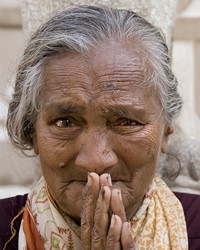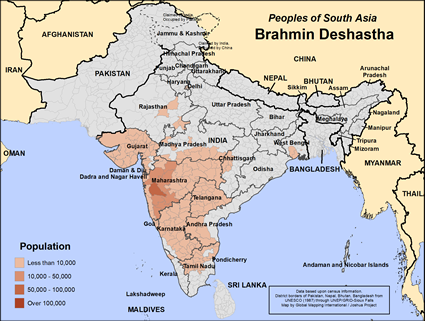Brahmin Deshastha in India

Photo Source:
Didi - Flickr
Creative Commons
|

Map Source:
People Group Location: Omid. Other geography / data: GMI. Map Design: Joshua Project
|
| People Name: | Brahmin Deshastha |
| Country: | India |
| 10/40 Window: | Yes |
| Population: | 568,000 |
| World Population: | 568,000 |
| Primary Language: | Marathi |
| Primary Religion: | Hinduism |
| Christian Adherents: | 0.00 % |
| Evangelicals: | 0.00 % |
| Scripture: | Complete Bible |
| Ministry Resources: | Yes |
| Jesus Film: | Yes |
| Audio Recordings: | Yes |
| People Cluster: | South Asia Forward Caste - Brahmin |
| Affinity Bloc: | South Asian Peoples |
| Progress Level: |
|
Introduction / History
The Deshastha Brahmins live in west central India. Their history goes back over three thousand years ago and to the time of the writing of the Vedas, the most ancient Hindu scriptures. Their name means "residents of the country." The Deshastha have a long history of Hindu philosophers, scholars, saints and famous priests. During the Maratha Empire (1647-1818) the Deshastha served as the leading priests, administrators and military officers of the realm.
The Deshastha speak Marathi in their homes. As educated Indians they also speak Hindi, English and other regional Indian languages.
The great majority of the Deshastha Brahmins live Maharashtra. Some also live in the Indian states of Karnataka, Gujarat and other regions of India.
What Are Their Lives Like?
Today the Deshastha officiate at the main Hindu temples of the Indian state of Maharashtra. They continue their role as Hindu priests, scholars and professors of religion. Some Deshastha have taken white-collar jobs as accountants, scientists, and mathematicians and in public administration.
Deshastha Brahmins live at the highest levels of Indian society. They strongly encourage their children to attain graduate degrees in universities. Most now live in urban centers but some still live in villages where they are the priests and accountants. Some Deshastha hold large tracts of land that is tilled by members of lower castes.
The Deshastha are endogamous, that is they marry only within their own group or caste. They are vegetarians although some young people in the cities have taken to eating meat except for beef.
Families arrange marriages with the consent of the young people. They allow cousin marriages. Babies receive their names from their father's sister.
What Are Their Beliefs?
They take pride in their Hindu heritage and are among the most devout Hindus in the nation. Some worship Vishnu as the supreme god. Ganesha and his festival, Ganesh Chaturthi, is the main holiday of the year. The Deshastha eat special foods and put a clay image of Ganesha or their family god into a river or the sea. Each Deshastha family has its own household shrine and patron deity. They offer food and incense to their gods at their private shrine and at public temples.
Others are attracted to the philosophical version of Hinduism. Such people often don't worship any of the Hindu gods.
What Are Their Needs?
The Deshastha Brahmins must see themselves as sinners in need of a savior. They need to realize that the gods of Hinduism will not forgive their sins or grant them eternal life. They need to see that the Bible not the Vedas is the inspired Word of God. They need to see true Christianity lived out before them.
Prayer Points
Pray for the Lord to bless the Deshantha Brahmins in such a way they cannot deny his sovereignty and goodness.
Pray for members of this community to accept Christ's ambassadors and listen to them.
Pray for Deshantha Brahmin disciples who will make more disciples.